By Roberta Bailey
Tucked in the back corner of many New England sheds or barns is a dusty old-fashioned ice cream maker. It has a wooden slat bucket held together with salt-rusted wire. The same rust is on the handle. There is a rust-frozen latch that holds the cranking mechanism on top of the bucket rim. A stainless-steel canister sits in the bucket and attaches to the top cranking mechanism. Inside there is a metal paddle with wooden blades that hooks into the lid and the cranking mechanism. Between the bucket and the canister is where the ice gets packed and layered with salt. To use it, one would fill the canister with pre-cooled ice cream mixture and crank for at least 40 minutes. Then keep tamping the ice and salt. When the mixture starts to really freeze up, they’d get a few extra hands to hold down the bucket and put the strongest person on the crank. When no one can budge that crank, it’s done.
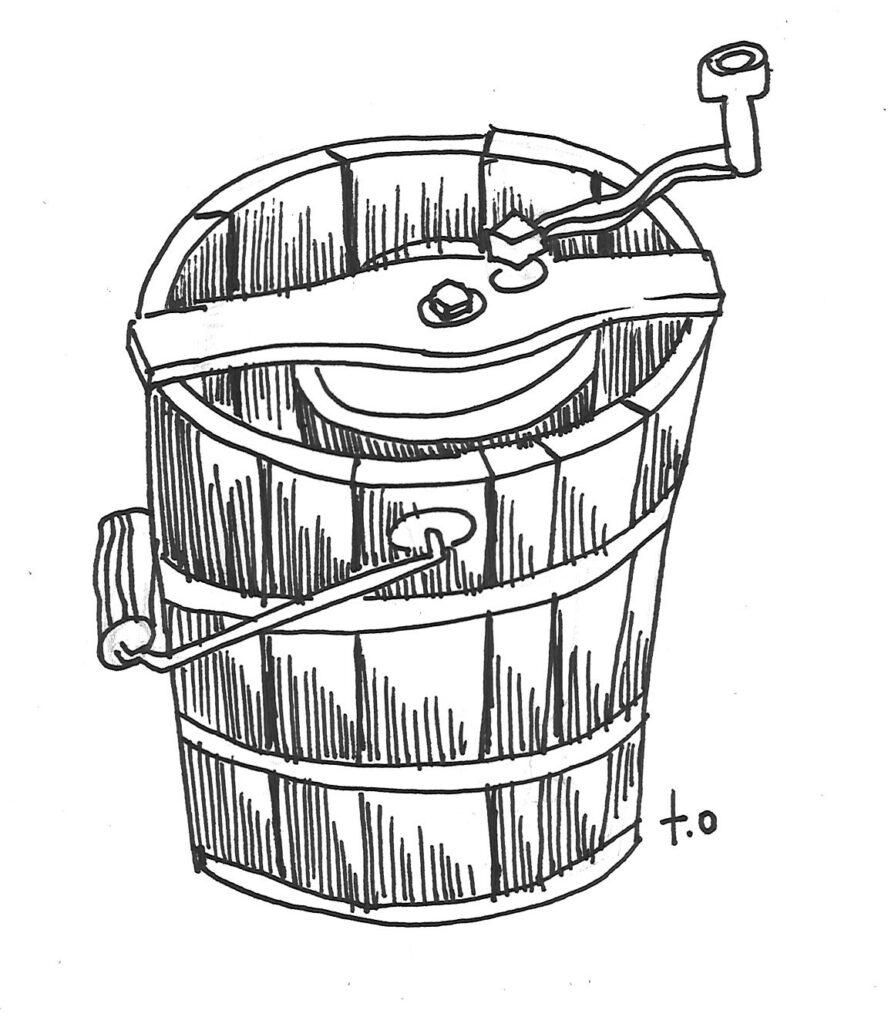
These days electric ice cream makers make the process easier and offer more control at specific times. Some are frozen bowls that fit an electric mixer, others are countertop models. Some even have compressors. If you use a hand-cranked ice cream maker, the ratio is one part salt to eight parts ice. Coarse salt, even rock salt, and crushed ice with more surface area release the most cold.
During this spring and summer, I have been learning more about ice cream. It started with making a lemongrass ice cream with cilantro, chives, and a dash of fish sauce. That first batch tasted surprisingly delicious, but it had formed large unappealing ice crystals throughout it. So, I pulled out Harold McGee’s “On Food and Cooking: The Science and Lore of the Kitchen,” and I learned some things.
We all know that commercial ice creams vary greatly. Inexpensive ice cream contains a minimum of 10% fat content. They often have a 100% “over run,” a term for the expansion rate of air churned into the mixture. One hundred percent means that once churned and frozen, that quart of liquid turned into a half gallon of fluffy ice cream. Premium ice creams usually have 20% fat content and a 50% over run. They are much denser.
Four and a half pounds is the federal standard for one gallon of ice cream. Some premium ice creams weigh in closer to 9 pounds. Less air, more real ingredients, plus no guar gum and fillers explains the price difference.
At home, using any style of ice cream maker, three factors influence your success: the sugar to fat ratio, the protein content, and air content. Fat, in the form of cream, contributes richness, smoothness, and body. Reducing fat content means there are fewer fat globules to separate the ice crystals, resulting in larger ice crystals and a coarser product. More sugar lowers the freezing point below the standard 27 degrees Fahrenheit. Sugar also helps to keep ice crystals small; less sugar creates bigger ice crystals. Sorbets lack fat and have less air and rely on twice as much sweetener for creamy textures. They need colder temperatures to freeze. Increased protein and fat, often in the form of egg yolks, helps make a smoother creamier ice cream, especially if making a savory or low-sugar dish. Churning adds air, which makes the ice cream softer and lighter. Air interrupts the liquid to solid phase of ice crystals. Air, sugar and fat, and churning speeds work together to keep ice crystals from binding and forming larger crystals. Once your mixture starts to freeze or thicken, churn faster to add more air. Fast churning early in the process can turn the cream to butter.
Frozen yogurt is a very quick way to make a sweet or savory concoction. One can make it with a non-dairy yogurt as well. Fruit or berries can be pureed and added to the yogurt. Sweeten to taste and chill for an hour before processing in an ice cream maker.
Coconut milk or other non-dairy milks can be used to make ice cream. Adding softened raw cashews, chia, flax seed or egg yolks, or one to two tablespoons of olive oil or vodka will help create a creamier texture. Thickening the milk with corn starch during the cooking process then cooling it seems to be a popular method.
Granitas are similar to a sorbet but frozen in a freezer with no churning. They are stirred with a fork as they freeze to create a granular iced confection, either sweet or savory. A few tablespoons of vodka or other hard liquor will make it less coarse.
If you do not have access to an ice cream maker, freezing an ice cream mixture until almost semi-firm then pureeing it in a blender, much like a smoothie with frozen berries, makes a pretty good ice cream-style dessert.
For creating savory flavors, one can blanch and puree fresh herbs, or add powdered herbs, to any dairy or sorbet base.
Below are some recipes that cover various preparation methods. Let your imagination wander the rows of your garden. This could be the summer of wild flavor combinations. Consider lobster, garlic, coconut cumin lime, curry. Black sesame, chamomile and blackberry, pear and bleu cheese and walnut, parmesan, or olive oil and lemon with pine nuts. I even came across a Caesar salad ice cream, though it is not on my summer list.
All can be stored in the freezer for a few months. Place a layer of wax paper or plastic over the ice cream to avoid ice crystals and the absorption of flavors.
Fresh Herb-Flavored Ice Cream
Choose your desired flavor profile, such as fresh basil, or cinnamon basil, lavender, rosemary, lemongrass, roasted garlic, or anise hyssop, or a combination of flavors. Consider adding fruit, berry, or candied lemon rind. Blueberry and basil, thyme and candied orange peel, or lavender and honey are big successes. My latest favorite is lemon mint. Anise hyssop is a close second.
One can steep fresh or dried herbs in the cream or blanch and thoroughly dry the fresh herbs and puree them to be added to the cooked mixture at the end. Straining is then recommended.
5 large egg yolks
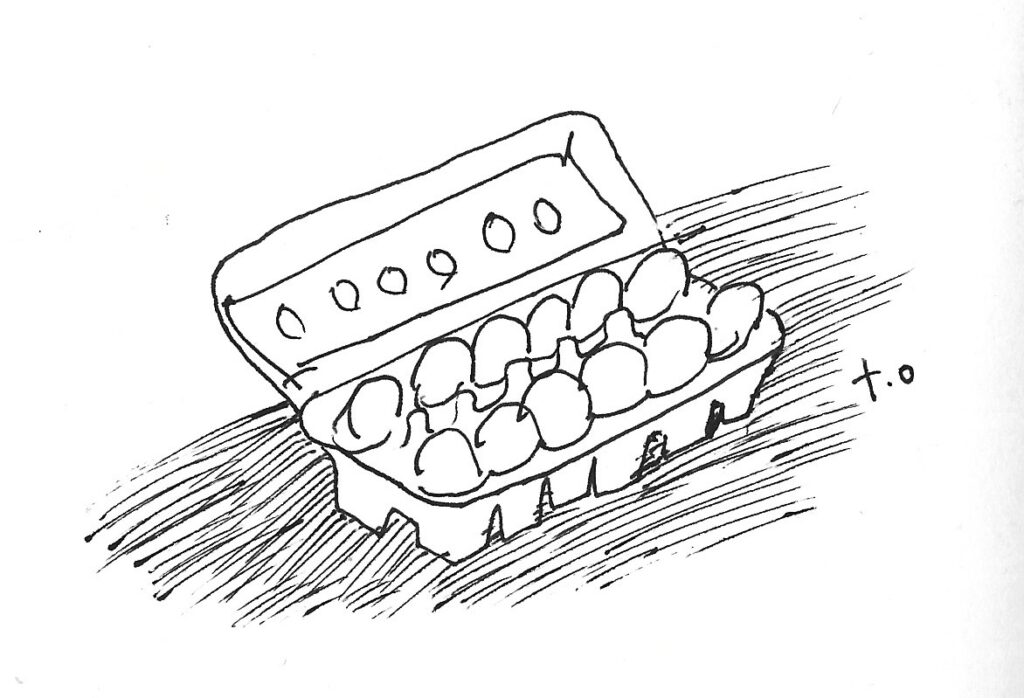
¾ cups sugar
1 cup heavy cream
2 cups whole milk
½ tsp. vanilla extract (optional)
Pinch of sea salt
1 ½ ounces fresh herbs
Whisk together the egg yolks and sugar, until the mixture falls from the whisk in ribbons. In a saucepan, combine the cream, milk, and vanilla (if using). Bring to a near boil, then remove from heat. Very slowly drizzle the egg mixture into the cream, whisking very vigorously the entire time. Set aside to cool over a bowl of ice or in a shallow pan in a freezer.
To blanch the fresh herbs, bring a pot of salted water to a boil. Immerse a bundle of herbs for 1 minute. Remove and pat dry. Remove coarse stems and puree the herbs in a small food processor. Fold the herb puree into the chilled cream base. Let the mixture infuse for an hour or overnight, if possible. Place the chilled mixture in your ice cream maker. Once churned to a firm but still slightly soft consistency, place in a container and into the freezer to firm it up.

Lemon-Rosemary Sorbet
(Or make another citrus-herb combination.)
1 ½ cups sugar
1 ½ cups water
⅓-½ cup rosemary, minced, or 2 Tbsp. dried
1 ⅓ cups fresh lemon juice
2 Tbsp. vodka (optional)
Over medium high heat, stir the water, sugar, and rosemary until the sugar dissolves, about 5 minutes. Remove from heat and stir in the lemon juice and optional vodka. Cool to room temperature. Placing it in a bed of ice expedites this step. Strain through a fine mesh sieve into a bowl. Chill to about 40 degrees. Process in your ice cream maker. Return to the bowl and place in the freezer to thoroughly freeze and firm up.
Sweet Corn and Polenta Ice Cream
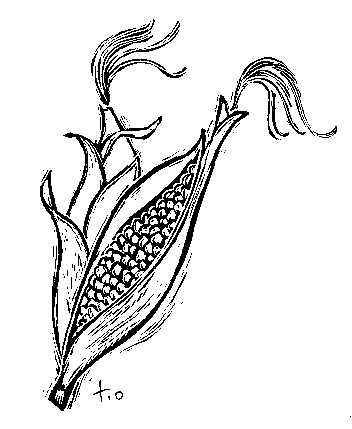
(Makes 1 ½ quarts.)
The polenta adds a deeper corn flavor.
3 cups whole milk
3 cups heavy cream
¼ cup polenta
2 Tbsp. honey
1 cup sugar (or use ¾ cup honey in total)
2 large ears of fresh corn
6 large egg yolks
Combine the milk, cream, polenta, and sugar in a heavy saucepan. (Wait on the honey until the end). Stir to combine. Grate the kernels from the cobs, using the coarse setting. Add the cobs, the kernels, and any milky corn juices to the cream mixture. Cook over medium heat, stirring to prevent sticking, until it comes to a boil. Turn off the heat, add the honey, and let the mixture rest for 30 minutes.
Carefully remove the cobs, then bring the mixture to a boil. Turn heat off quickly. Place the egg yolks in a mixing bowl. Whisk to break them up. To temper the yolks, add a ladleful of hot mixture to the yolks, while whisking them vigorously. Continue to whisk and add cream until all the liquid has been added. Strain through a fine-mesh sieve to remove the polenta and corn kernels. Strain again if desired. Chill over a bowl of ice. Chill in the freezer to about 40 degrees.
Churn in your ice cream maker, increasing the speed once it starts to freeze (if possible). The ice cream will be the consistency of soft serve. Chill for 2-4 hours before serving.
Savory Granita
(For serving with oysters or meat.)
½ cup red wine vinegar
1 small shallot
5 crushed peppercorns
¼ tsp. fine sea salt
¼ tsp. honey
Combine all ingredients in a small saucepan. Bring to a boil for 30 seconds. Remove from heat and cool completely. Strain through a fine-meshed sieve. Pour the liquid into a shallow baking pan. Freeze the mixture, stirring every 45 minutes with a fork to create a grainy ice texture, for about 3 hours. Serve as a side or topping for oysters, fish, or meats.
Coconut Milk Ice Cream
2 (15 oz.) cans full-fat coconut milk
½ cup granulated sugar, maple sugar, or date sugar (to use honey in your base, add after the boiling and thickening process)
1 ½ Tbsp. cornstarch
2 tsp. vanilla extract
⅛ tsp. sea salt
Set aside ½ cup of coconut milk. Add the remaining coconut milk, sweetener, and salt to a saucepan. Place over medium heat and whisk until the sweetener is dissolved. Add the vanilla extract. Mix the cornstarch into the reserved coconut milk, then whisk it into the saucepan. Bring to a boil, stirring to avoid sticking. Boil for 5 minutes, until the base is thickened.
Refrigerate the base until thoroughly chilled. Churn in an ice cream maker until thick, place in a bowl to finish hardening in the freezer.
One can flavor the coconut milk with herbs or savory ingredients like cilantro, mustard, bacon, or ginger. Perhaps leave out the vanilla or use less sweetener (or a different sweetener).
Peanut Butter Curry Ice Cream
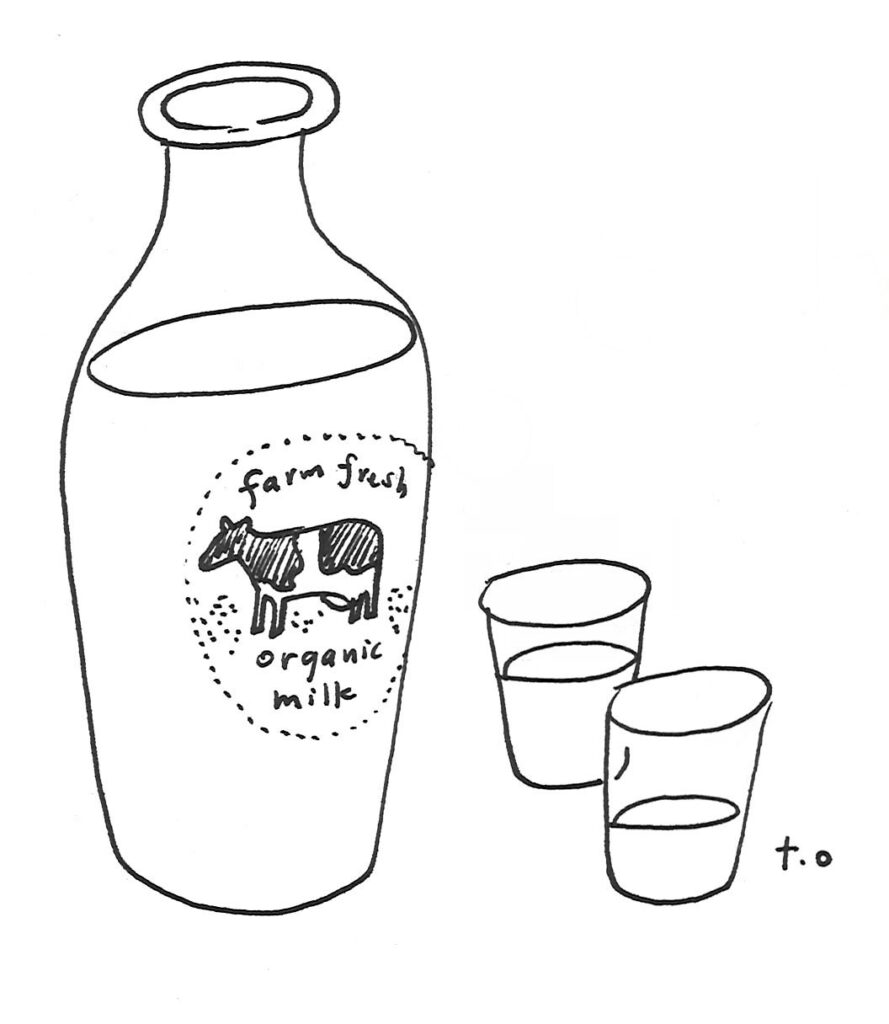
1 ½ cups heavy cream
1 ½ cups whole milk
¼ tsp. salt
5 egg yolks
1 cup sugar
¾ cup natural peanut butter
½ tsp. vanilla extract
3 tsp. curry powder
Combine the cream, milk, and salt in a saucepan. Heat to just below a boil; then remove from the heat. In a separate bowl, whisk the egg yolks and the sugar, then add the peanut butter, the curry powder, and vanilla. Whisk to combine.
Slowly add ½ cup of the cream to the egg mixture, whisking vigorously. Then slowly whisk the egg mixture into the saucepan while continuing to whisk it. Return the saucepan to medium heat, and stir until thickened (the mixture should coat the back of the spoon). Remove from the heat. Strain if desired. Pour into a shallow pan or bowl and place over a bed of ice to chill. Then refrigerate for 2-4 hours or overnight. Transfer to an ice cream maker and churn. Place in a bowl to freeze to a harder consistency if desired. Will store for two months in a covered container.
Oat or Almond Milk Ice Cream
(Use this as a base, which can be flavored creatively.)
2 cups raw unsalted cashews
2 cups soy, almond, or oat milk (or other non-dairy milk)
½ cup maple syrup
1 tsp. vanilla extract or other flavoring (optional)
Place the cashews in a bowl and cover with water. Soak overnight to soften. Or
blend with half your almond milk until creamy. Add the remaining milk and maple syrup. Blend until thick and frothy. Turn into your ice cream maker and churn until thick. Add fruit or other additions just as the mixture begins to thicken.
This mixture will get very hard in the freezer, so serve immediately or freeze then allow it to soften before serving.
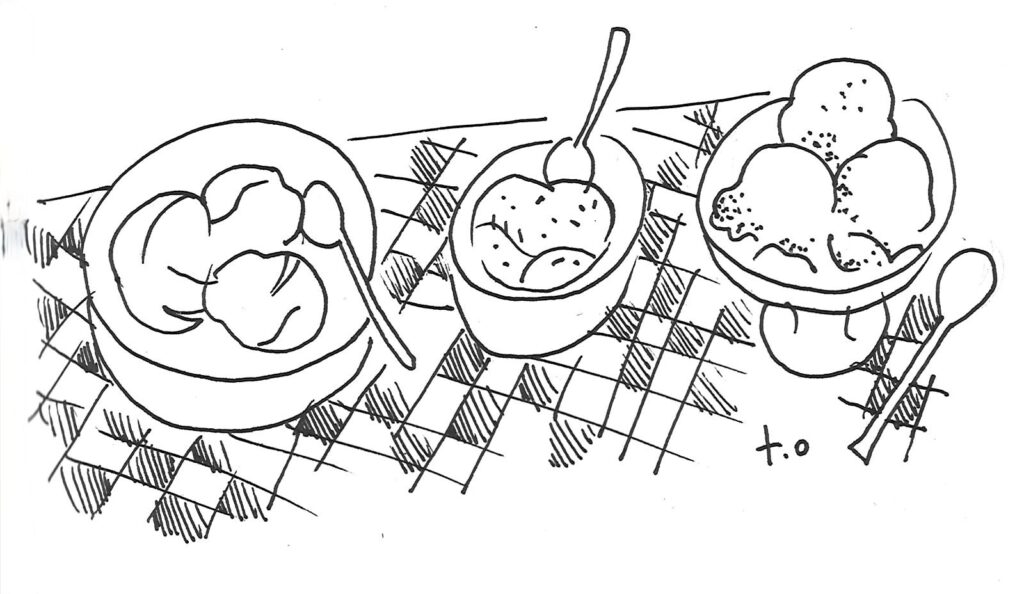
This article was originally published in the summer 2025 issue of The Maine Organic Farmer & Gardener.